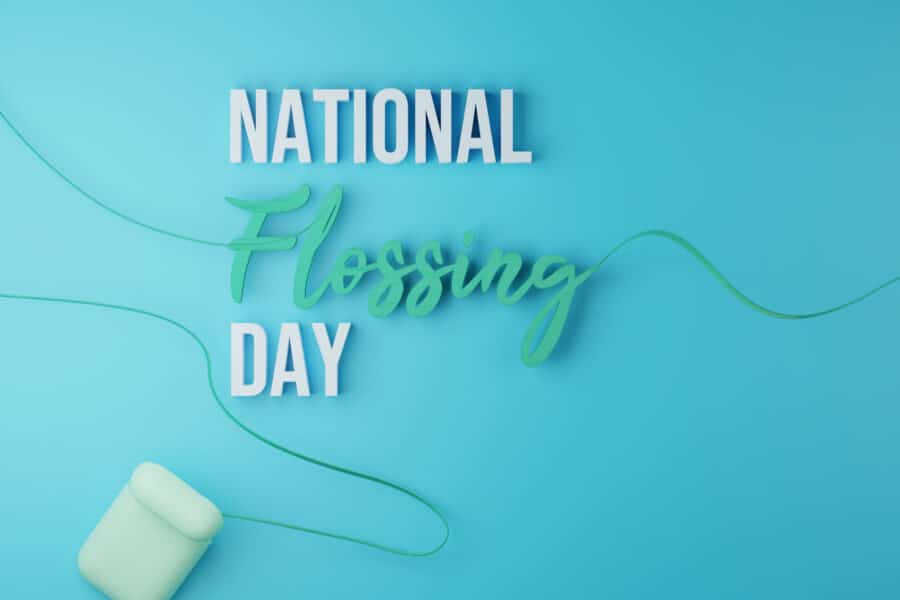It’s a fact, flossing daily helps protect against gingivitis by removing plaque and food particles, keeping your teeth and gums healthy, while giving you a beautiful smile.
So, do you floss daily?
Probably not! Well, you’re not alone because according to an American Dental Association (ADA) survey, only 16% of patients report flossing daily.
The main reason people say they don’t floss every day is because it takes too much time but, flossing is a very important aspect of your gum health. In fact, the American Academy of Periodontology says, “Gum disease is typically caused when prolonged exposure to bacteria in dental plaque causes an inflammatory reaction. Flossing is an effective and useful way to remove the plaque, especially in between the teeth or under the gum line-places where a toothbrush cannot reach.”
Some people find flossing difficult, others say it makes their gums bleed or sore. Well, that bleeding and soreness means bacteria is causing an infection between your teeth. Flossing removes that!
Here are a few tips to start making flossing part of your daily routine:
Create Flossing Cues
- One of the easiest ways to remind yourself to floss more is to create a flossing cue, a way to remind you to do it. This can be as simple as a sticky note on your bathroom mirror or a reminder alarm on your phone. There are even dental apps that help you set reminders such as Brush DJ. The app helps you to brush your teeth for the full two minutes to a randomly selected song from your playlist. The app entertains you with music while you brush, making brushing fun and exciting rather than boring. The app also allows you to set reminders to brush twice a day, floss, and see your dentist or hygienist regularly. Brush DJ is a free app.
Chunk Floss
- Studies in neuroscience show that one way to create a new habit is by chunking the desired one with something you already do. This action, called ‘habit-chunking’ can work for flossing too. Pick something that you do every day, dental or non-dental, and put floss there. Before you do that daily habit, floss first. By chunking, you basically trick your brain into creating a new habit without thinking too much about it.
Stash Floss Everywhere!
- If you only floss by the mirror, it may seem like a time-consuming chore, ut if you have it stashed in places like your purse, pocket, car, or by the TV, you can do it when you have any extra minute. So, stock up on floss, LOTS OF IT!
Find the flossing product that works best for you
- Not everyone has to use string floss. Some find it difficult to maneuver while others think it is just plain slimy. If you have sensitive teeth and gums that bleed easily, choose a soft floss that slides easily and comfortably between the teeth. There are also many alternatives to string floss such as floss holders, floss picks, and water flossers.
Types of floss:
- Traditional Waxed Floss – this is the typical offering. The wax can help make it easier to get the floss between your teeth so if you have really tiny spaces this could be a good option for you.
- Non-waxed floss – The lack of wax might make the floss a bit thinner, but the absence of the wax acting as a lubricant might make it a little more difficult to thread between your teeth.
- Disposable Toothpicks – these have grown in popularity and can be a great option, whether you’re on the go or just need help getting those tough to reach back teeth. These come in large packs at most grocery stores and are great for having on hand at all times. Throw a few in your backpack or purse in case you find yourself away from the house and in need of a quick floss.
- Floss Threaders – these handy tools are especially great for individuals with braces or permanent retainers. You can take your floss and place it inside the threader and then use the threader to guide the floss where you need it to go.
- Electric or Water Flossers – these handy tools can be great for those who really can’t get into the regular routine of flossing, they use a combination of pressure and water to clean away plaque and stuck food from the hard to reach areas between your teeth. These are great options but might not clean the entire area. They can be a little more expensive and they might make more of a mess during your daily routine.
*It is always best to discuss floss alternatives with your dental professionals*
Reward Yourself After You’re Done!
- Just as individuals can form good habits, it’s also possible for bad habits to form. Help get yourself excited about flossing by rewarding yourself after you’ve done it. If you have a favorite TV show wait to watch it until after you’ve completed your flossing or mark off the number of days in a row you floss on your calendar and after 30 consecutive days allow yourself a special treat.
Take Baby Steps
- Start taking baby steps toward more flossing. Flossing a few times a week is better than not at all. It can even lead to more regular flossing later! You can even start by flossing just one tooth. Flossing just one tooth isn’t going to improve your overall periodontal health right away. But that’s not the point. The point is to make the act of flossing a habit, which will eventually lead to improved gum health. All you have to do to feel successful is to floss one single tooth at a time.
Don’t ever feel defeated if you can’t seem to make it a daily habit. Just keep trying to do your best and know that we are always here to help you find tools and tips to clean in-between your teeth.
Keep in mind that flossing correctly is just as important as how often you do it. Here is a step-by-step guide and video by the ADA on proper flossing.



